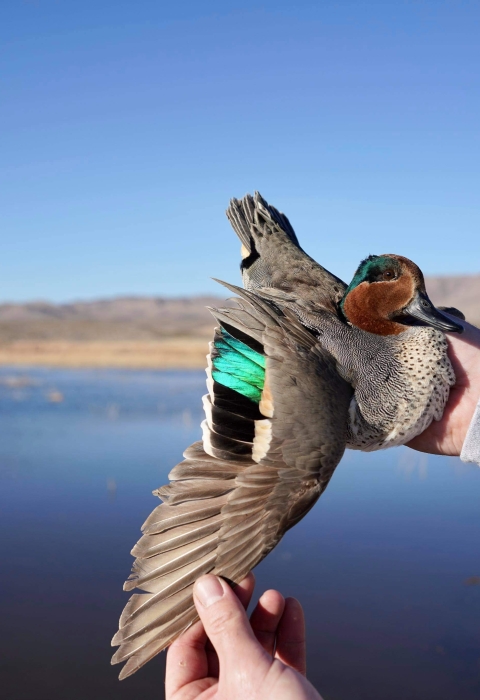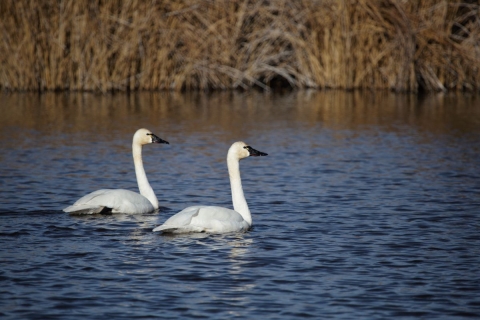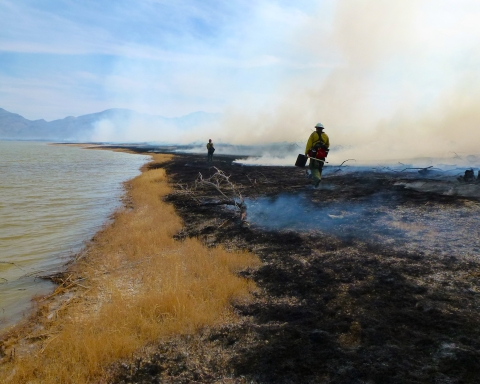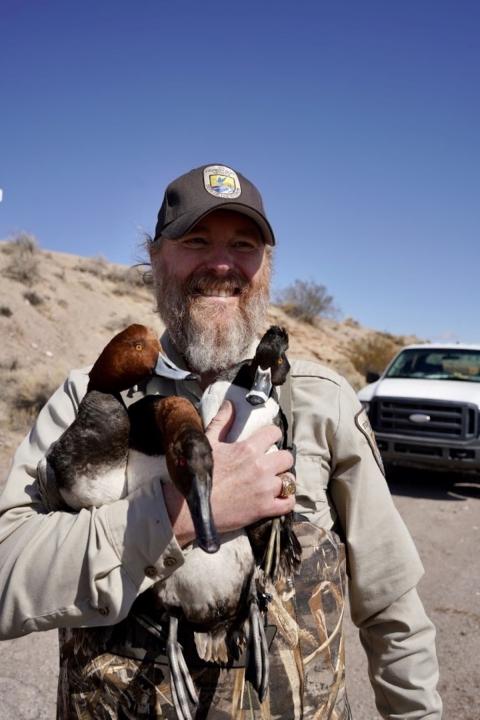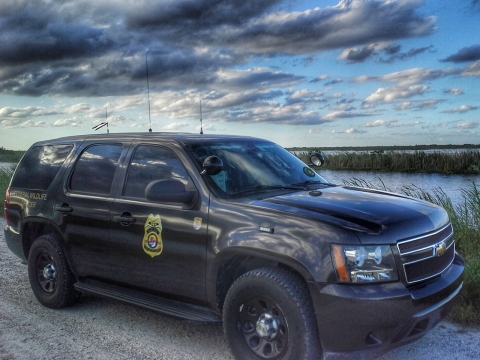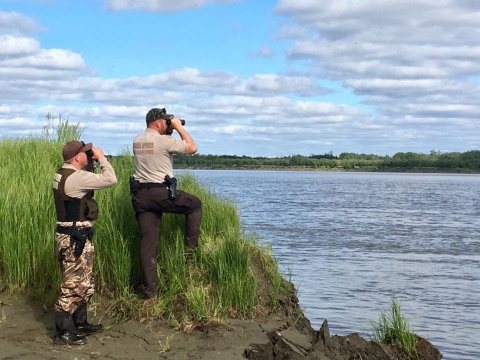What We Do
The National Wildlife Refuge System is a series of lands and waters owned and managed by the U.S. Fish and Wildlife Service. Wildlife conservation is at the heart of the refuge system. It drives everything we do from establishing the purpose of a refuge, to the recreational activities offered there, to the resource management tools we use. Selecting the right tools helps us ensure the survival of local plants and animals and helps fulfill the purpose of the refuge.
Refuges use a wide range of land management tools based on the best science available. Some refuges use prescribed fires to mimic natural fires that would have cleared old vegetation from the land helping native plants regenerate and local wildlife to thrive. Other refuges contain Wilderness areas where land is largely managed in a passive manner. The management tools used are aimed at ensuring a balanced conservation approach where both wildlife and people will benefit. Since Pahranagat National
Wildlife Refuge was established for migratory birds, specifically waterfowl, conservation work at this field station involves active wetland and habitat management for their benefit.
Management and Conservation
Here at Pahranagat National Wildlife Refuge we use active wetland and habitat management techniques such as water manipulation, mechanical disturbances, and prescribed burns, all of which benefit migratory birds during their breeding season, the winter season, and during fall and spring migrations. Other conservation tools that are utilized include the removal of invasive plant species, habitat surveys, data collection and wildlife surveys, and seasonally closing certain areas to the public for native revegetation and to provide a sanctuary for wildlife free of all human disturbances.
Pahranagat also has a Comprehensive Conservation Plan (CCP). The purpose of a CCP is to specify a management direction for the Refuge for the next 15 years. The goals, objectives, and strategies for improving Refuge conditions—including the types of habitat we will provide, partnership opportunities, and management actions needed to achieve desired conditions – are described in the CCP. The Service’s preferred alternative for managing the Refuge and its effects on the human environment, are described in the CCP as well.
Refuge Planning
National Wildlife Refuge planning sets the broad vision for refuge management and the goals, objectives, strategies, and actions required to achieve it. Planning ensures that each refuge meets its individual purposes, contributes to the Refuge System’s mission and priorities, is consistent with other applicable laws and policies, and enhances conservation benefits beyond refuge boundaries.
Comprehensive Conservation Plans
Comprehensive Conservation Plans (CCPs) are the primary planning documents for National Wildlife Refuges. As outlined in the National Wildlife Refuge System Administration Act, as amended, the U.S. Fish and Wildlife Service (Service) is required to develop CCPs that guide refuge management for the next 15 years. CCPs articulate the Service’s contributions to meeting refuge purposes and the National Wildlife Refuge System mission. CCPs serve as a bridge between broad, landscape-level plans developed by other agencies and stakeholders and the more detailed step-downs that stem from Refuge CCPs.
The 2009 Final Comprehensive Conservation Plan for Desert, Ash Meadows, Moapa Valley, and Pahranagat National Wildlife Refuges can be found here: https://ecos.fws.gov/ServCat/Reference/Profile/7305
Step-down Plans
CCP step-down plans guide refuge-level programs for: (1) conserving natural resources (e.g., fish, wildlife, plants, and the ecosystems they depend on for habitat); (2) stewarding other special values of the refuge (e.g., cultural or archeological resources, wilderness, wild and scenic rivers, etc.); and (3) engaging visitors and the community in conservation, including providing opportunities for wildlife-dependent recreation. Like CCPs, step-down plans contribute to the implementation of relevant landscape plans by developing SMART (Specific, Measurable, Achievable, Relevant, and Time-bound) objectives, strategies, implementation schedules, and decision support tools to fulfill refuge visions and goals. This ensures that refuges are managed in a landscape context and that conservation benefits extend beyond refuge boundaries.
Our Projects and Research
Wetlands, wet meadows, upland plant communities, natural springs, and cultural history entice scientists and scholars to study the Refuge resources and further human understanding of the processes and environments that are the foundation for the rich diversity of life on Pahranagat NWR and how humans have interacted with that environment over millennia. Other researchers focus on understanding the role of southwestern wetlands and diversity in the regional and national refuge system, the preeminent example of a habitat conservation system in the United States and perhaps the world. This ever-expanding understanding contributes to conservation and management of Mojave Desert environments important to southern Nevada, the southwest, and the United States.
One project that takes place here at Pahranagat is southwestern willow flycatcher surveys that are conducted each summer in the protected North Marsh by SWCA Environmental Consultants, one of our partners. The survey provides population status information of the flycatchers and includes an assessment of site occupancy, breeding indices, nest parasitism rates, and color band individuals to gain more information about flycatcher site fidelity, dispersal, and survival. Pahranagat NWR is just one of many sites surveyed, but this project plays an important role in the survival of the species.
Many of the projects that take place on the Refuge are funded by the Southern Nevada Public Land Management Act (SNPLMA). It allows the Bureau of Land Management to sell public land within a specific boundary around Las Vegas, Nevada. The revenue derived from land sales is split between the State of Nevada General Education Fund (5%), the Southern Nevada Water Authority (10%), and a special account available to the Secretary of the Interior. Projects that are funded by SNPLMA are submitted each year to the Secretary of Interior for approval and typically fall into one or more of the following categories; parks, trails, and natural areas, capital improvements, conservation initiatives, Multi-Species Habitat Conservation Plan (MSHCP), environmentally sensitive land acquisitions, hazardous fuels reduction and wildfire prevention, Eastern Nevada landscape restoration project, or the Lake Tahoe restoration project. A few projects that have been funded by SNPLMA in the past at Pahranagat are the Visitor Center trail improvements, the creation of interpretative trails at Black Canyon, dam and water control structure structure
Something temporarily or permanently constructed, built, or placed; and constructed of natural or manufactured parts including, but not limited to, a building, shed, cabin, porch, bridge, walkway, stair steps, sign, landing, platform, dock, rack, fence, telecommunication device, antennae, fish cleaning table, satellite dish/mount, or well head.
Learn more about structure improvements, habitat restoration and wildlife surveys, and creating accessible trails and parking spaces.
Law Enforcement
U.S. Fish and Wildlife Service law enforcement officers have a wide variety of duties and responsibilities. Officers work to protect fish, wildlife, plants, and other natural, cultural, and historical resources; and help visitors understand and obey wildlife protection laws. By fostering understanding and instilling in the visiting public an appreciation of refuge resources, laws, and regulations, our law enforcement encourages voluntary compliance through education, outreach, and law enforcement actions while in a welcoming and safe environment. Refuge law enforcement works collaboratively with law enforcement officers from other federal land management agencies to protect wildlife habitats in Southern Nevada for the benefit of all.
Laws and Regulations
Various activities such as biking, camping, boating, fishing, hunting, and recreating with pets are permitted at the Refuge but are subject to certain rules and regulations that must be followed. There are also particular rules and regulations surrounding vehicle use within the Refuge boundary. Other activities such as swimming, horseback riding, and the use of drones are not permitted within Refuge boundaries. Please note that some areas are not open to the public and have restricted access.
